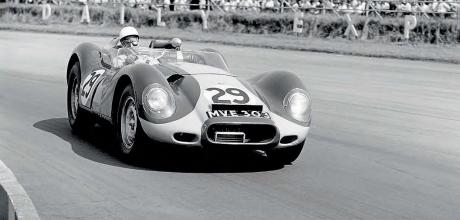Stirling Moss wins Silverstone with Lister-Jaguar, July 1958
Due to its aerodynamic magnesium body, lightweight tubular chassis and Jaguar’s powerful 3.4-litre XK engine, ever since its introduction in 1957, the Lister ‘Knobbly’ (so called due to the tall front wheelarches flanking its low nose) had quickly become the car to beat in international sports car racing. One of the other main reasons for the car’s success was Lister’s works driver, the Scot Archie Scott Brown. Despite having a badly deformed hand and severe mobility problems with his legs, he was still an immensely talented and courageous driver.
“Nature always compensates,” said Brian Lister years later, “and in Archie’s case, I believe it had given him the most incredible sense of balance which is what made him such a superb driver. He used to say he’d won all the slow-bicycling races at school – just by balancing there completely stationary while everybody else fell off. I never doubted it.” But on May 18, 1958, while dicing with American driver Masten Gregory’s Ecurie Ecosse Lister-Jaguar at Spa-Francorchamps, the Scot hit a road sign which snapped the track rod end, causing a high-speed accident. After rolling down a slope, the car’s fuel tank sprung a leak resulting in the magnesium-bodied car catching fire. Despite the seriousness of his injuries, Brown was initially conscious, saying, “Well, I made a bloody mess of that, didn’t I?” before sadly dying the next day.
As a fundamental part of his team’s success, Brian Lister was naturally devastated. “After Archie’s death, my immediate impulse was to retire from racing,” said Lister in Doug Nye’s 1980 book, Powered by Jaguar, “but as a company we had existing contracts and commitments and one had to put personal feelings to one side and get on with the job.”
Following a brief pause in Lister’s racing commitments, in early July Ivor Bueb won at the Crystal Palace circuit in South London. But the prestigious British Grand Prix meeting at Silverstone in which Lister had entered two cars in the support race for sportscars was just two weeks away and he didn’t have a replacement of the same calibre as Brown. “I was determined to get the best driver I could,” continued Lister in Powered by Jaguar, “and BP – who were not the most generous of sponsors – arranged for Stirling Moss to join us. He was not too expensive, and if he’d wanted a fortune I’d have probably paid it just for the satisfaction of blowing off Gregory and Ecosse.”
This wasn’t the first time Moss had raced for Lister, having driven its earlier Bristol-powered car at Goodwood in 1954. But the Grand Prix meeting was a much bigger event and attracted a highly competitive grid that consisted of several other Lister- Jaguars, four Lotus 15s, a Jaguar D-Type and Aston Martin DB3S.
Yet from the outset, Moss dominated the weekend, taking pole by out-qualifying Gregory (who was again in Ecosse’s Lister) by two seconds. The American later crashed heavily while trying to match Moss’s time, breaking his arm and retiring from the race.
This left another American, Walt Hansgen, in the second works Lister-Jaguar as Moss’s main rival. But with the British driver at the zenith of his career, he led from the start and won easily, posting an average speed of an incredible 97.2mph, which was quicker than his fastest lap at Silverstone in a Maserati F1 car four years earlier. “The Knobbly remains one of my favourite racing cars,” said Moss in 2016. “I remember getting into it in 1958 and thinking, ‘Who is going to beat me in this?’”
Moss raced a Lister-Jaguar just once more, at Sebring in March 1959, but this time it had a new, even more aerodynamic body designed by leading British engineer, Frank Costin. Unfortunately, he ran out of fuel while leading in the rain.
Still not over Brown’s death, Brian Lister withdrew from racing at the end of 1959 season. This meant Moss’s victory at Silverstone the year before was one of the company’s final major successes.
“Brian Lister’s cars were always engineered to an incredible degree,” continued Moss in 2016. “His passion for technical excellence and dedication to staying ahead of the pack was without equal, yet he was always such a complete gentleman. I thrived on that – it was always a real pleasure to drive for him.”


